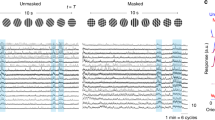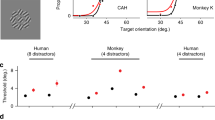Abstract
Perception of a visual target and the responses of cortical neurons can be strongly influenced by a context surrounding the target1,2,3,4,5,6,7,8,9,10,11,12,13,14,15,16,17,18,19,20,21,22,23,24,25,26,27. This observation relates to the fundamental issue of how cortical neurons code objects of the external world. In high-contrast regimes, embedding a target in an iso-oriented context reduces neural responses and deteriorates performance in psychophysical experiments. Performance from orthogonal surrounds is better than that from iso-oriented ones1,2,3,4,5,6,7,8,9,10,11,12,13,14,15,16,17. This contextual interference is often postulated to be caused by long- or short-range interactions between neurons tuned to orientation. Here we show, using a new illusion called ‘shine-through’ as a sensitive psychophysical probe, that the orientation difference between target and context does not determine performance. Instead, contextual modulation depends on the overall spatial structure of the context. We propose that contextual suppression vanishes if the contextual elements are grouped to an independent and coherent object.
This is a preview of subscription content, access via your institution
Access options
Subscribe to this journal
Receive 51 print issues and online access
$199.00 per year
only $3.90 per issue
Buy this article
- Purchase on Springer Link
- Instant access to full article PDF
Prices may be subject to local taxes which are calculated during checkout




Similar content being viewed by others
References
Knierim, J. J. & van Essen, D. C. Neuronal responses to static texture patterns in area V1 of the alert macaque monkey. J. Neurophys. 67, 961–980 (1992).
Li, W., Thier, P. & Wehrhahn, C. Contextual influence on orientation discrimination of humans and responses of neurons in V1 of alert monkeys. J. Neurophys. 83, 941–954 (2000).
Nothdurft, H.-C., Gallant, J. L. & van Essen, D. C. Response modulation by texture surround in primate area V1: Correlates of pop-out under anesthesia. Vis. Neurosci. 16, 15–34 (1999).
Herzog, M. H. & Koch, C. Seeing properties of an invisible element: feature inheritance and shine-through. Proc. Natl Acad. Sci. USA 98, 4271–4275 (2001).
Herzog, M. H., Fahle, M. & Koch, C. Spatial aspects of object formation revealed by a new illusion, shine-through. Vis. Res. 41, 2325–2335 (2001).
Mareschal, I., Sceniak, M. P. & Shapley, M. Contextual influences on orientation discrimination: binding local and global cues. Vis. Res. 41, 1915–1930 (2001).
Wehrhahn, C., Li, W. & Westheimer, G. Patterns that impair discrimination of orientation in human vision. Perception 25, 1053–1064 (1996).
Stemmler, M., Usher, M. & Niebur, E. Lateral interactions in primary visual cortex: a model bridging physiology and psychophysics. Science 269, 1877–1880 (1995).
Li, Z. Contextual influences in V1 as a basis for pop out and asymmetry in visual search. Proc. Natl Acad. Sci. USA 96, 10530–10535 (1999).
Wolfson, S. S. & Landy, M. S. Long range interactions between oriented texture elements. Vis. Res. 39, 933–945 (1999).
Nothdurft, H. C. Texture segmentation and pop-out from orientation contrast. Vis. Res. 31, 1073–1078 (1991).
Cannon, M. W. & Fullenkamp, S. C. Spatial interactions in apparent contrast: inhibitory effects among grating patterns of different spatial frequencies, spatial positions and orientations. Vis. Res. 31, 1985–1998 (1991).
Lamme, V. A. The neurophysiology of figure-ground segregation in primary visual cortex. J. Neurosci. 15, 1605–1615 (1995).
Zipser, K., Lamme, V. A. F. & Schiller, P. H. Contextual modulation in primary visual cortex. J. Neurosci. 16, 7376–7389 (1996).
Caputo, G. The role of the background: Texture segregation and figure-ground segmentation. Vis. Res. 36, 2815–2826 (1996).
Sengpiel, F., Sen A. & Blakemore, C. Characteristics of surround inhibition in cat area 17. Exp. Brain Res. 116, 216–228 (1997).
Sillito, A. M., Grieve, K. L., Jones, H. E., Cudeiro, J. & Davis, J. Visual cortical mechanisms detecting focal orientation discontinuities. Nature 378, 492–496 (1995).
Macknik, S. L. & Livingstone, M. S. Neuronal correlates of visibility and invisibility in the primate visual system. Nature Neurosci. 1, 144–149 (1998).
Polat, U. & Sagi, D. Lateral interactions between spatial channels: suppression and facilitation revealed by lateral masking experiments. Vis. Res. 33, 993–999 (1993).
Kapadia, M. K., Ito, M., Gilbert, C. D. & Westheimer, G. Improvement in visual sensitivity by changes in local context: parallel studies in human observers and in V1 of alert monkeys. Neuron 15, 843–856 (1995).
Levitt, J. B. & Lund, J. S. Contrast dependence of contextual effects in primate visual cortex. Nature 387, 73–76 (1997).
Bonneh, Y. & Sagi, D. Effects of spatial configuration on contrast detection. Vis. Res. 38, 3541–53 (1998).
Yu, C. & Levi, D. Surround modulation in human vision unmasked by masking experiments. Nature Neurosci. 3, 724–728 (2000).
Das, A. & Gilbert, C. D. Topography of contextual modulations mediated by short-range interactions in primary visual cortex. Nature 399, 655–661 (1999).
Chubb, C., Sperling, G. & Solomon, J. A. Texture interactions determine perceived contrast. Proc. Natl Acad. Sci. USA 86, 9631–9635 (1989).
Weisstein, N. & Harris, C. S. Visual detection of lines segments: an object-superiority effect. Science 186, 752–755 (1974).
Banks, W. P. & White, H. Lateral interference and perceptual grouping in visual detection. Percept. Psychophys. 36, 285–295 (1984).
Kurylo, D. D. Time course of perceptual grouping. Percept. Psychophys. 59, 142–147 (1997).
Ernst, U. A., Pawelzik, K. R., Sahar-Pikielny, C. & Tsodyks, M. V. Intracortical origin of visual maps. Nature Neurosci. 4, 431–436 (2001).
Acknowledgements
This work was supported by the Center of Excellence (SFB) ‘Neurocognition’ of the German Research Council (Deutsche Forschungsgemeinschaft). We thank M. Repnow for technical support; and B. Gillam, C. Eurich, U. Ernst, A. Etzold, B. Zenger, K. Neumann, F. Kandil, J. Solomon, M. Morgan, J. Zanker and U. Schmonsees for discussions.
Author information
Authors and Affiliations
Corresponding author
Ethics declarations
Competing interests
The authors declare no competing financial interests.
Rights and permissions
About this article
Cite this article
Herzog, M., Fahle, M. Effects of grouping in contextual modulation. Nature 415, 433–436 (2002). https://doi.org/10.1038/415433a
Received:
Accepted:
Issue Date:
DOI: https://doi.org/10.1038/415433a
This article is cited by
-
Four-dot masking in monoptic and dichoptic viewing
Scientific Reports (2020)
-
Situational context is important: perceptual grouping modulates temporal perception
Cognitive Processing (2015)
-
Training improves visual processing speed and generalizes to untrained functions
Scientific Reports (2014)
-
Contextual suppression and protection in schizophrenic patients
European Archives of Psychiatry and Clinical Neuroscience (2008)
Comments
By submitting a comment you agree to abide by our Terms and Community Guidelines. If you find something abusive or that does not comply with our terms or guidelines please flag it as inappropriate.



